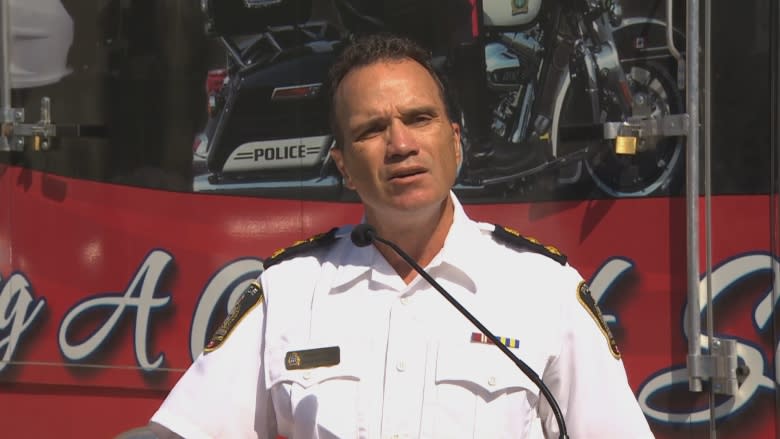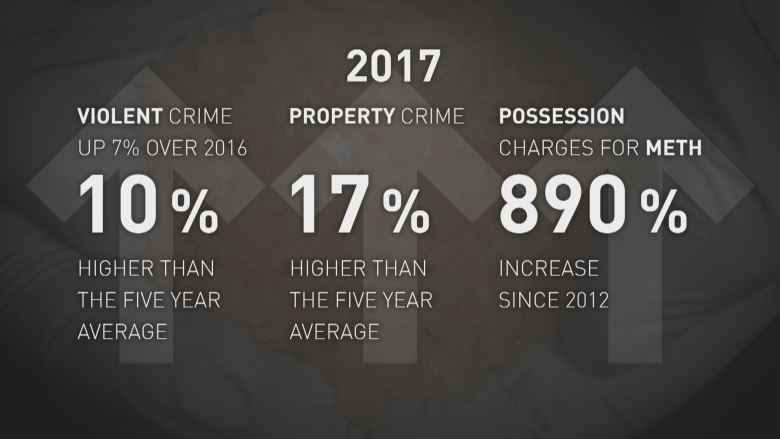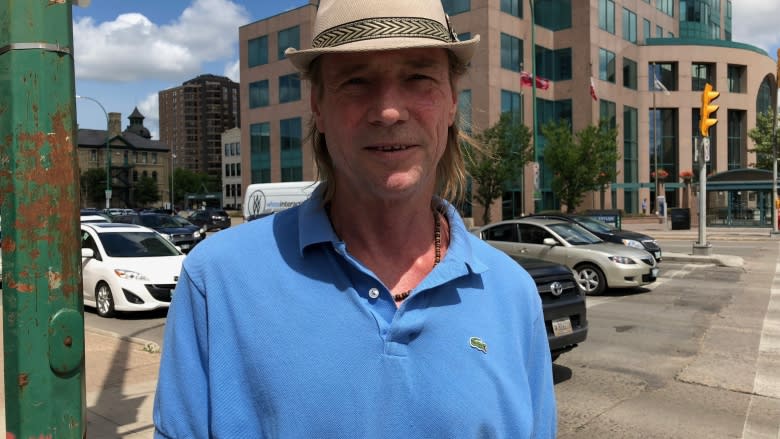'Community in crisis': Drugs fuelling increase in crime, Winnipeg police chief says
Drugs, particularly the growing use of methamphetamine, are fuelling crime in Winnipeg and putting a huge strain on city services, says police Chief Danny Symth.
The number of violent crimes is up seven per cent over 2016, and was 10 per cent higher last year than the city's five-year average, the Winnipeg Police Service's annual report says.
When the population increase is taken into account, the per capita violent crime rate was five per cent higher year-over-year and was four per cent higher than the city's five-year average.
In addition, the number of property crimes has increased nine per cent and drug crime has risen 15 per cent over last year, the report says.
But similar to violent crime, when population is taken into account, those figures drop to seven per cent and 13 per cent, respectively.
Smyth said one-third of all homicides in the city in 2017 — eight out of 24 — were directly related to illicit drugs, specifically methamphetamine.
The growing use of methamphetamine is not only exhausting police resources, but straining health care, addictions treatment centres, and even affecting city transit, Smyth said during a news conference Monday morning.
"This is a community in crisis," he said.
A graphic released by the police service says police have seen possession charges for meth increase 890 per cent since 2012.
"Sadly, not a week goes by where I don't speak with a parent who's begging me to arrest their child for meth use because it's the only way they can access treatment or ensure their safety," Smyth said.
"This is tragic."
The Winnipeg Police Service has dedicated more officers to focus on fighting the illicit drug trade, he said.
But he sees gaps in programming that need to be addressed, he said.
In particular, the city needs more services to get people stabilized when they quit using so they can enter a treatment program, and more programs for people who want to get out of gangs, he said.
In a statement, Health Minister Kelvin Goertzen said the province is making those investments — with justice system improvements, quick-access clinics for addictions medicine, and money from the Proceeds of Crime Fund and Criminal Property Forfeiture Fund for innovative new programs.
'A lot of meth'
Winnipeg Police Association president Maurice Sabourin, in contrast, laid blame on cancelled cadet classes and fewer police on the streets.
"When you don't give frontline police officers the resources needed to do the job, crime is going to go up, period," said Sabourin. "The proof of that is clearly spelled out in this latest annual report. Criminals don't plan their activities based on the rate of inflation. When you give them an opening, they take it — and more."
Garth Bell, a property manager for buildings in the Spence neighbourhood, says he feels safe because he knows how to handle himself — but things have been getting worse.
He says more people have been trying to get into his buildings at night, whether to sleep or do drugs.
"The youth are all over the place, especially at night," he said. "They have the run of the place, basically after dark. You wouldn't want to be walking around here ... they just look for trouble, except it's not innocent trouble. They're malevolent. A lot of meth."
However, CBC spoke to several people in the area who said they feel safe.
Nyala Ali, who works at the University of Winnipeg and lives in the West End, said she normally goes out in daytime hours. But if anything, she wondered if there had been a decrease in the Spence area near the university.
"If I see something, I might remove myself from the direct thing going on, but I might keep an eye out in case someone is in distress and needs help," she said.
Community activist Sel Burrows said more resources are needed to fight crime and addictions, but he'd also like to see efforts to stop the problem before it starts.
"How bout prevention? Have you heard the mayor or the premier or the attorney general talk about any money going into prevention? Wouldn't that make more sense? How do we stop people getting started on meth?" he said.
The data in the annual report is compiled and produced by the Winnipeg Police Service research and development unit. It has data from Winnipeg proper, but not outlying communities within the city's census metropolitan area.
Crime up in rural Manitoba too
Statistics Canada says higher crime rates were reported in rural areas of Manitoba in 2017 as well.
In 2017, per capita crime rates in rural Manitoba were 42 per cent higher than crime rates in urban areas, says a report released by Statistics Canada on Monday.
Almost half of the crime reported in Canada's rural areas in 2017 took place in Manitoba, Saskatchewan and Alberta, though these provinces accounted for only a quarter of Canada's population served by rural police services.
The crime rate measures the volume of crime reported to police per 100,000 population.




